Microstructure and Mechanical Properties of Ti-6Al-4V In Situ Alloyed with 3 wt% Cr by Laser Powder Bed Fusion
Abstract
1. Introduction
2. Materials and Methods
3. Results
3.1. Rheological Powder Properties and Part Density
3.2. Chemical Composition
3.3. XRD
3.4. SEM
3.5. EBSD
3.6. STEM
3.7. Thermodynamic Calculation
3.8. Mechanical Properties
4. Discussion
4.1. Processability
4.2. Microstructure
4.3. Mechanical Properties
5. Conclusions
- (1)
- With LPBF in situ alloying 3 wt% Cr to Ti-6Al-4V, crack-free specimens with an RD of 99.14 ± 0.11% were produced. The addition of Cr was found to be effective in modifying microstructural and mechanical properties of Ti-6Al-4V.
- (2)
- In situ martensite decomposition was observed. Initially, primary β was transformed into α’. The preheating of the substrate plate to 500 °C and the reheating of the lower layers during LPBF allowed the thermally driven diffusion reaction of α’⟶α + β to take place.
- (3)
- The addition of Cr resulted in thermal supercooling during solidification and induced the reduction of columnar grain growth. The grain size of primary β in the BD was significantly decreased. Thermal supercooling also results in the breakdown of the 〈100〉β texture typical of Ti-6Al-4V. This microstructure might result in more isotropic mechanical properties.
- (4)
- The presence of the B19 phase was confirmed. It is proposed that B19 is the transformation product of the former B2, as predicted by thermodynamic calculations considering the Fe impurities present in the material.
- (5)
- The Rp0.2, the UTS, and A were 1359 ± 23 MPa, 1450 ± 22 MPa, and 4.5 ± 0.2%, respectively. The Rp0.2 and the UTS are higher, but A is in the same range as the values for Ti-6Al-4V produced by LPBF.
Author Contributions
Funding
Data Availability Statement
Acknowledgments
Conflicts of Interest
References
- Mair, P.; Goettgens, V.S.; Rainer, T.; Weinberger, N.; Letofsky-Papst, I.; Mitsche, S.; Leichtfried, G. Laser powder bed fusion of nano-CaB6 decorated 2024 aluminum alloy. J. Alloys Compd. 2021, 863, 158714. [Google Scholar] [CrossRef]
- Yang, J.; Yu, H.; Yin, J.; Gao, M.; Wang, Z.; Zeng, X. Formation and control of martensite in Ti-6Al-4V alloy produced by selective laser melting. Mater. Des. 2016, 108, 308–318. [Google Scholar] [CrossRef]
- Xu, W.; Lui, E.W.; Pateras, A.; Qian, M.; Brandt, M. In situ tailoring microstructure in additively manufactured Ti-6Al-4V for superior mechanical performance. Acta Mater. 2017, 125, 390–400. [Google Scholar] [CrossRef]
- Simonelli, M.; Tse, Y.Y.; Tuck, C. On the texture formation of selective laser melted Ti-6Al-4V. Metall. Mater. Trans. A Phys. Metall. Mater. Sci. 2014, 45, 2863–2872. [Google Scholar] [CrossRef]
- Xu, Y.; Zhang, D.; Guo, Y.; Hu, S.; Wu, X.; Jiang, Y. Microstructural tailoring of As-Selective Laser Melted Ti6Al4V alloy for high mechanical properties. J. Alloys Compd. 2020, 816, 152536. [Google Scholar] [CrossRef]
- He, J.; Li, D.; Jiang, W.; Ke, L.; Qin, G.; Ye, Y.; Qin, Q.; Qiu, D. The Martensitic Transformation and Mechanical Properties of Ti6Al4V Prepared via Selective Laser Melting. Materials 2019, 12, 321. [Google Scholar] [CrossRef]
- Cao, S.; Chu, R.; Zhou, X.; Yang, K.; Jia, Q.; Lim, C.V.S.; Huang, A.; Wu, X. Role of martensite decomposition in tensile properties of selective laser melted Ti-6Al-4V. J. Alloys Compd. 2018, 744, 357–363. [Google Scholar] [CrossRef]
- Kumar, P.; Ramamurty, U. Microstructural optimization through heat treatment for enhancing the fracture toughness and fatigue crack growth resistance of selective laser melted Ti–6Al–4V alloy. Acta Mater. 2019, 169, 45–59. [Google Scholar] [CrossRef]
- Zafari, A.; Barati, M.R.; Xia, K. Controlling martensitic decomposition during selective laser melting to achieve best ductility in high strength Ti-6Al-4V. Mater. Sci. Eng. A 2019, 744, 445–455. [Google Scholar] [CrossRef]
- Mosallanejad, M.H.; Niroumand, B.; Aversa, A.; Saboori, A. In-situ alloying in laser-based additive manufacturing processes: A critical review. J. Alloys Compd. 2021, 872, 159567. [Google Scholar] [CrossRef]
- Nagase, T.; Hori, T.; Todai, M.; Sun, S.H.; Nakano, T. Additive manufacturing of dense components in beta-titanium alloys with crystallographic texture from a mixture of pure metallic element powders. Mater. Des. 2019, 173, 107771. [Google Scholar] [CrossRef]
- Wang, J.; Liu, Y.; Rabadia, C.D.; Liang, S.X.; Sercombe, T.B.; Zhang, L.C. Microstructural homogeneity and mechanical behavior of a selective laser melted Ti-35Nb alloy produced from an elemental powder mixture. J. Mater. Sci. Technol. 2021, 61, 221–233. [Google Scholar] [CrossRef]
- Huang, S.; Narayan, R.L.; Tan, J.H.K.; Sing, S.L.; Yeong, W.Y. Resolving the porosity-unmelted inclusion dilemma during in-situ alloying of Ti34Nb via laser powder bed fusion. Acta Mater. 2021, 204, 116522. [Google Scholar] [CrossRef]
- Zhang, X.; Ye, W.; Mushongera, L.; Liao, Y. Unravelling heterogeneities in sub-grain cellular structure and micromechanical response of additive manufactured Ti-Nb alloys. Addit. Manuf. 2022, 59, 103146. [Google Scholar] [CrossRef]
- Chmielewska, A.; Wysocki, B.; Buhagiar, J.; Michalski, B.; Adamczyk-Cieślak, B.; Gloc, M.; Święszkowski, W. In situ alloying of NiTi: Influence of laser powder bed fusion (LBPF) scanning strategy on chemical composition. Mater. Today Commun. 2022, 30, 103007. [Google Scholar] [CrossRef]
- Chlebus, E.; Kuźnicka, B.; Dziedzic, R.; Kurzynowski, T. Titanium alloyed with rhenium by selective laser melting. Mater. Sci. Eng. A 2015, 620, 155–163. [Google Scholar] [CrossRef]
- Gussone, J.; Bugelnig, K.; Barriobero-Vila, P.; da Silva, J.C.; Hecht, U.; Dresbach, C.; Sket, F.; Cloetens, P.; Stark, A.; Schell, N.; et al. Ultrafine eutectic Ti-Fe-based alloys processed by additive manufacturing—A new candidate for high temperature applications. Appl. Mater. Today 2020, 20, 100767. [Google Scholar] [CrossRef]
- Vilardell, A.M.; Yadroitsev, I.; Yadroitsava, I.; Albu, M.; Takata, N.; Kobashi, M.; Krakhmalev, P.; Kouprianoff, D.; Kothleitner, G.; du Plessis, A. Manufacturing and characterization of in-situ alloyed Ti6Al4V(ELI)-3 at.% Cu by laser powder bed fusion. Addit. Manuf. 2020, 36, 101436. [Google Scholar] [CrossRef]
- Krakhmalev, P.; Yadroitsev, I.; Yadroitsava, I.; de Smidt, O. Functionalization of biomedical Ti6Al4V via in situ alloying by Cu during laser powder bed fusion manufacturing. Materials 2017, 10, 1154. [Google Scholar] [CrossRef]
- Guo, S.; Lu, Y.; Wu, S.; Liu, L.; He, M.; Zhao, C.; Gan, Y.; Lin, J.; Luo, J.; Xu, X.; et al. Preliminary study on the corrosion resistance, antibacterial activity and cytotoxicity of selective-laser-melted Ti6Al4V-xCu alloys. Mater. Sci. Eng. C 2017, 72, 631–640. [Google Scholar] [CrossRef]
- Vrancken, B.; Thijs, L.; Kruth, J.P.; Van Humbeeck, J. Microstructure and mechanical properties of a novel β titanium metallic composite by selective laser melting. Acta Mater. 2014, 68, 150–158. [Google Scholar] [CrossRef]
- Zhang, T.; Huang, Z.; Yang, T.; Kong, H.; Luan, J.; Wang, A.; Wang, D.; Kuo, W.; Wang, Y.; Liu, C.-T. In situ design of advanced titanium alloy with concentration modulations by additive manufacturing. Science 2021, 374, 478–482. [Google Scholar] [CrossRef] [PubMed]
- Goettgens, V.S.; Kaserer, L.; Braun, J.; Letofsky-Papst, I.; Mitsche, S.; Leichtfried, G. Microstructure of a modulated Ti-6Al-4V—Cu alloy fabricated via in situ alloying in laser powder bed fusion. Materialia 2023, 28, 101731. [Google Scholar] [CrossRef]
- Kolli, R.P.; Devaraj, A. A review of metastable beta titanium alloys. Metals 2018, 8, 506. [Google Scholar] [CrossRef]
- Hayat, M.A.; Suliman, S.M.A. An economical heat treatment cycle for IMI Ti-230. Mater. Manuf. Process. 1998, 13, 203–212. [Google Scholar] [CrossRef]
- Donachie, M.J. Titanium—A Techincal Guide; ASM International: Almere, The Netherlands, 2000; Volume 99. [Google Scholar] [CrossRef]
- Ho, W.F.; Chiang, T.Y.; Wu, S.C.; Hsu, H.C. Mechanical properties and deformation behavior of cast binary Ti-Cr alloys. J. Alloys Compd. 2009, 468, 533–538. [Google Scholar] [CrossRef]
- Hsu, H.C.; Wu, S.C.; Chiang, T.Y.; Ho, W.F. Structure and grindability of dental Ti-Cr alloys. J. Alloys Compd. 2009, 476, 817–825. [Google Scholar] [CrossRef]
- Bermingham, M.J.; McDonald, S.D.; StJohn, D.H.; Dargusch, M.S. Segregation and grain refinement in cast titanium alloys. J. Mater. Res. 2009, 24, 1529–1535. [Google Scholar] [CrossRef]
- Andersson, J.O.; Helander, T.; Höglund, L.; Shi, P.; Sundman, B. Thermo-Calc & DICTRA, computational tools for materials science. Calphad Comput. Coupling Phase Diagr. Thermochem. 2002, 26, 273–312. [Google Scholar] [CrossRef]
- Fukuda, T.; Saburi, T.; Chihara, T.; Tsuzuki, Y. Mechanism of B2-B19-B19’ Transformation in Shape Memory Ti-Ni-Cu Alloys. Mater. Trans. JIM 1995, 36, 1244–1248. [Google Scholar] [CrossRef]
- Vrancken, B.; Thijs, L.; Kruth, J.P.; Van Humbeeck, J. Heat treatment of Ti6Al4V produced by Selective Laser Melting: Microstructure and mechanical properties. J. Alloys Compd. 2012, 541, 177–185. [Google Scholar] [CrossRef]
- Cain, V.; Thijs, L.; Van Humbeeck, J.; Van Hooreweder, B.; Knutsen, R. Crack propagation and fracture toughness of Ti6Al4V alloy produced by selective laser melting. Addit. Manuf. 2015, 5, 68–76. [Google Scholar] [CrossRef]
- Rafi, H.K.; Karthik, N.V.; Gong, H.; Starr, T.L.; Stucker, B.E. Microstructures and mechanical properties of Ti6Al4V parts fabricated by selective laser melting and electron beam melting. J. Mater. Eng. Perform. 2013, 22, 3872–3883. [Google Scholar] [CrossRef]
- Facchini, L.; Magalini, E.; Robotti, P.; Molinari, A.; Höges, S.; Wissenbach, K. Ductility of a Ti-6Al-4V alloy produced by selective laser melting of prealloyed powders. Rapid Prototyp. J. 2010, 16, 450–459. [Google Scholar] [CrossRef]
- Vilaro, T.; Colin, C.; Bartout, J.D. As-fabricated and heat-treated microstructures of the Ti-6Al-4V alloy processed by selective laser melting. Metall. Mater. Trans. A Phys. Metall. Mater. Sci. 2011, 42, 3190–3199. [Google Scholar] [CrossRef]
- Zhang, D.; Wang, L.; Zhang, H.; Maldar, A.; Zhu, G.; Chen, W.; Park, J.-S.; Wang, J.; Zeng, X. Effect of heat treatment on the tensile behavior of selective laser melted Ti-6Al-4V by in situ X-ray characterization. Acta Mater. 2020, 189, 93–104. [Google Scholar] [CrossRef]
- Hao, T. Understanding empirical powder flowability criteria scaled by Hausner ratio or Carr index with the analogous viscosity concept. RSC Adv. 2015, 5, 57212–57215. [Google Scholar] [CrossRef]
- Montalbano, T.; Briggs, B.N.; Waterman, J.L.; Nimer, S.; Peitsch, C.; Sopcisak, J.; Trigg, D.; Storck, S. Uncovering the coupled impact of defect morphology and microstructure on the tensile behavior of Ti-6Al-4V fabricated via laser powder bed fusion. J. Mater. Process. Technol. 2021, 294, 117113. [Google Scholar] [CrossRef]
- Dilip, J.J.S.; Zhang, S.; Teng, C.; Zeng, K.; Robinson, C.; Pal, D.; Stucker, B. Influence of processing parameters on the evolution of melt pool, porosity, and microstructures in Ti-6Al-4V alloy parts fabricated by selective laser melting. Prog. Addit. Manuf. 2017, 2, 157–167. [Google Scholar] [CrossRef]
- Karayagiz, K.; Elwany, A.; Tapia, G.; Franco, B.; Johnson, L.; Ma, J.; Karaman, I.; Arróyave, R. Numerical and experimental analysis of heat distribution in the laser powder bed fusion of Ti-6Al-4V. IISE Trans. 2019, 51, 136–152. [Google Scholar] [CrossRef]
- Xing, L.L.; Zhang, W.J.; Zhao, C.C.; Gao, W.Q.; Shen, Z.J.; Liu, W. Influence of powder bed temperature on the microstructure and mechanical properties of ti-6al-4v alloys fabricated via laser powder bed fusion. Materials 2021, 14, 2278. [Google Scholar] [CrossRef] [PubMed]
- Kenel, C.; Grolimund, D.; Li, X.; Panepucci, E.; Samson, V.A.; Sanchez, D.F.; Marone, F.; Leinenbach, C. In situ investigation of phase transformations in Ti-6Al-4V under additive manufacturing conditions combining laser melting and high-speed micro-X-ray diffraction. Sci. Rep. 2017, 7, 16358. [Google Scholar] [CrossRef] [PubMed]
- Neelakantan, S.; Rivera-Díaz-del-Castillo, P.E.J.; van der Zwaag, S. Prediction of the martensite start temperature for β titanium alloys as a function of composition. Scr. Mater. 2009, 60, 611–614. [Google Scholar] [CrossRef]
- Pantawane, M.V.; Dasari, S.; Mantri, S.A.; Banerjee, R.; Dahotre, N.B. Rapid thermokinetics driven nanoscale vanadium clustering within martensite laths in laser powder bed fused additively manufactured Ti6Al4V. Mater. Res. Lett. 2020, 8, 383–389. [Google Scholar] [CrossRef]
- Pantawane, M.V.; Ho, Y.H.; Joshi, S.S.; Dahotre, N.B. Computational Assessment of Thermokinetics and Associated Microstructural Evolution in Laser Powder Bed Fusion Manufacturing of Ti6Al4V Alloy. Sci. Rep. 2020, 10, 7579. [Google Scholar] [CrossRef]
- Goettgens, V.S.; Kaserer, L.; Braun, J.; Busch, R.; Berthold, L.; Patzig, C.; Leichtfried, G. Microstructural evolution and mechanical properties of Ti-6Al-4V in situ alloyed with 3.5 wt.% Cu by laser powder bed fusion. Materialia 2023, 32, 101928. [Google Scholar] [CrossRef]
- Gao, X.; Zhang, S.; Wang, L.; Yang, K.; Wang, P.; Chen, H. Evolution of grain boundary α phase during cooling from β phase field in a α + β titanium alloy. Mater. Lett. 2021, 301, 130318. [Google Scholar] [CrossRef]
- Liu, J.; Zhang, K.; Yang, Y.; Wang, H.; Zhu, Y.; Huang, A. Grain boundary α-phase precipitation and coarsening: Comparing laser powder bed fusion with as-cast Ti-6Al-4V. Scr. Mater. 2022, 207, 114261. [Google Scholar] [CrossRef]
- Xu, W.; Brandt, M.; Sun, S.; Elambasseril, J.; Liu, Q.; Latham, K.; Xia, K.; Qian, M. Additive manufacturing of strong and ductile Ti-6Al-4V by selective laser melting via in situ martensite decomposition. Acta Mater. 2015, 85, 74–84. [Google Scholar] [CrossRef]
- Wu, M.W.; Chen, J.K.; Tsai, M.K.; Wang, S.H.; Lai, P.H. Intensification of preferred orientation in the additive manufactured Ti-6Al-4V alloy after heat treatment. Mater. Lett. 2021, 286, 129198. [Google Scholar] [CrossRef]
- Tan, Q.; Yin, Y.; Prasad, A.; Li, G.; Zhu, Q.; StJohn, D.H.; Zhang, M.-X. Demonstrating the roles of solute and nucleant in grain refinement of additively manufactured aluminium alloys. Addit. Manuf. 2022, 49, 102516. [Google Scholar] [CrossRef]
- Bermingham, M.; StJohn, D.; Easton, M.; Yuan, L.; Dargusch, M. Revealing the Mechanisms of Grain Nucleation and Formation During Additive Manufacturing. JOM 2020, 72, 1065–1073. [Google Scholar] [CrossRef]
- Bermingham, M.J.; StJohn, D.H.; Krynen, J.; Tedman-Jones, S.; Dargusch, M.S. Promoting the columnar to equiaxed transition and grain refinement of titanium alloys during additive manufacturing. Acta Mater. 2019, 168, 261–274. [Google Scholar] [CrossRef]
- Braun, J.; Kaserer, L.; Stajkovic, J.; Kestler, H.; Leichtfried, G. Grain refinement mechanisms of alloying molybdenum with carbon manufactured by laser powder bed fusion. Mater. Des. 2022, 215, 110507. [Google Scholar] [CrossRef]
- Rappaz, M.; David, S.A.; Vitek, J.M.; Boatner, L.A. Development of microstructures in Fe-15Ni-15Cr single crystal electron beam welds. Metall. Trans. A 1989, 20, 1125–1138. [Google Scholar] [CrossRef]
- Wilson-Heid, A.E.; Wang, Z.; McCornac, B.; Beese, A.M. Quantitative relationship between anisotropic strain to failure and grain morphology in additively manufactured Ti-6Al-4V. Mater. Sci. Eng. A 2017, 706, 287–294. [Google Scholar] [CrossRef]
- He, Y.; Ma, Y.; Zhang, W.; Wang, Z. Anisotropic tensile and fatigue properties of laser powder bed fusion Ti6Al4V under high temperature. Eng. Fract. Mech. 2022, 276, 108948. [Google Scholar] [CrossRef]
- Pantawane, M.V.; Yang, T.; Jin, Y.; Joshi, S.S.; Dasari, S.; Sharma, A.; Krokhin, A.; Srinivasan, S.G.; Banerjee, R.; Neogi, A.; et al. Crystallographic texture dependent bulk anisotropic elastic response of additively manufactured Ti6Al4V. Sci. Rep. 2021, 11, 633. [Google Scholar] [CrossRef] [PubMed]
- Simonelli, M.; Tse, Y.Y.; Tuck, C. Effect of the build orientation on the mechanical properties and fracture modes of SLM Ti-6Al-4V. Mater. Sci. Eng. A 2014, 616, 1–11. [Google Scholar] [CrossRef]
- Sewak, R.; Dey, C.C. Martensitic phase transformation in TiNi. Sci. Rep. 2019, 9, 13500. [Google Scholar] [CrossRef]
- Otsuka, K.; Ren, X. Physical metallurgy of Ti-Ni-based shape memory alloys. Prog. Mater. Sci. 2005, 50, 511–678. [Google Scholar] [CrossRef]
- Tadaki, T.; Wayman, C.M. Electron microscopy studies of martensitic transformations in Ti50Ni50−xCux alloys. Part II. Morphology and crystal structure of martensites. Metallography 1982, 15, 247–258. [Google Scholar] [CrossRef]
- Miyamoto, H.; Taniwaki, T.; Ohba, T.; Otsuka, K.; Nishigori, S.; Kato, K. Two-stage B2-B19-B19′ martensitic transformation in a Ti50Ni30Cu20 alloy observed by synchrotron radiation. Scr. Mater. 2005, 53, 171–175. [Google Scholar] [CrossRef]
- Abe, E.; Kumagai, T.; Nakamura, M. New ordered structure of TiAl studied by high-resolution electron microscopy. Intermetallics 1996, 4, 327–333. [Google Scholar] [CrossRef]
- Schmoelzer, T.; Stark, A.; Schwaighofer, E.; Lippman, T.; Mayer, S.; Clemens, H. In Situ Synchrotron Study of B19 Phase Formation in an Intermetallic γ-TiAl Alloy.pdf. Adv. Eng. Mater. 2012, 14, 445–448. [Google Scholar] [CrossRef]
- Song, L.; Xu, X.J.; You, L.; Liang, Y.F.; Lin, J.P. B19 phase in Ti-45Al-8.5Nb-0.2W-0.2B-0.02Y alloy. J. Alloys Compd. 2015, 618, 305–310. [Google Scholar] [CrossRef]
- Ducher, R.; Viguier, B.; Lacaze, J. Modification of the crystallographic structure of γ-TiAl alloyed with iron. Scr. Mater. 2002, 47, 307–313. [Google Scholar] [CrossRef]
- Li, H.; Jia, D.; Yang, Z.; Liao, X.; Jin, H.; Cai, D.; Zhou, Y. Effect of heat treatment on microstructure evolution and mechanical properties of selective laser melted Ti–6Al–4V and TiB/Ti–6Al–4V composite: A comparative study. Mater. Sci. Eng. A 2021, 801, 140415. [Google Scholar] [CrossRef]
- Zhao, G.H.; Liang, X.Z.; Kim, B.; Rivera-Díaz-del-Castillo, P.E.J. Modelling strengthening mechanisms in beta-type Ti alloys. Mater. Sci. Eng. A 2019, 756, 156–160. [Google Scholar] [CrossRef]
- Kan, W.H.; Gao, M.; Zhang, X.; Liang, E.; Chiu, N.S.L.; Lim, C.V.S.; Huang, A. The influence of porosity on Ti-6Al-4V parts fabricated by laser powder bed fusion in the pursuit of process efficiency. Int. J. Adv. Manuf. Technol. 2022, 119, 5417–5438. [Google Scholar] [CrossRef]
- Liu, C.M.; Wang, H.M.; Tian, X.J.; Liu, D. Development of a pre-heat treatment for obtaining discontinuous grain boundary α in laser melting deposited Ti-5Al-5Mo-5V-1Cr-1Fe alloy. Mater. Sci. Eng. A 2014, 604, 176–182. [Google Scholar] [CrossRef]
- Carroll, B.E.; Palmer, T.A.; Beese, A.M. Anisotropic tensile behavior of Ti-6Al-4V components fabricated with directed energy deposition additive manufacturing. Acta Mater. 2015, 87, 309–320. [Google Scholar] [CrossRef]
- Wen, Y.; Wang, L.; Liu, H.; Song, L. Ab initio study of the elastic and mechanical properties of b19 TiAl. Crystals 2017, 7, 39. [Google Scholar] [CrossRef]

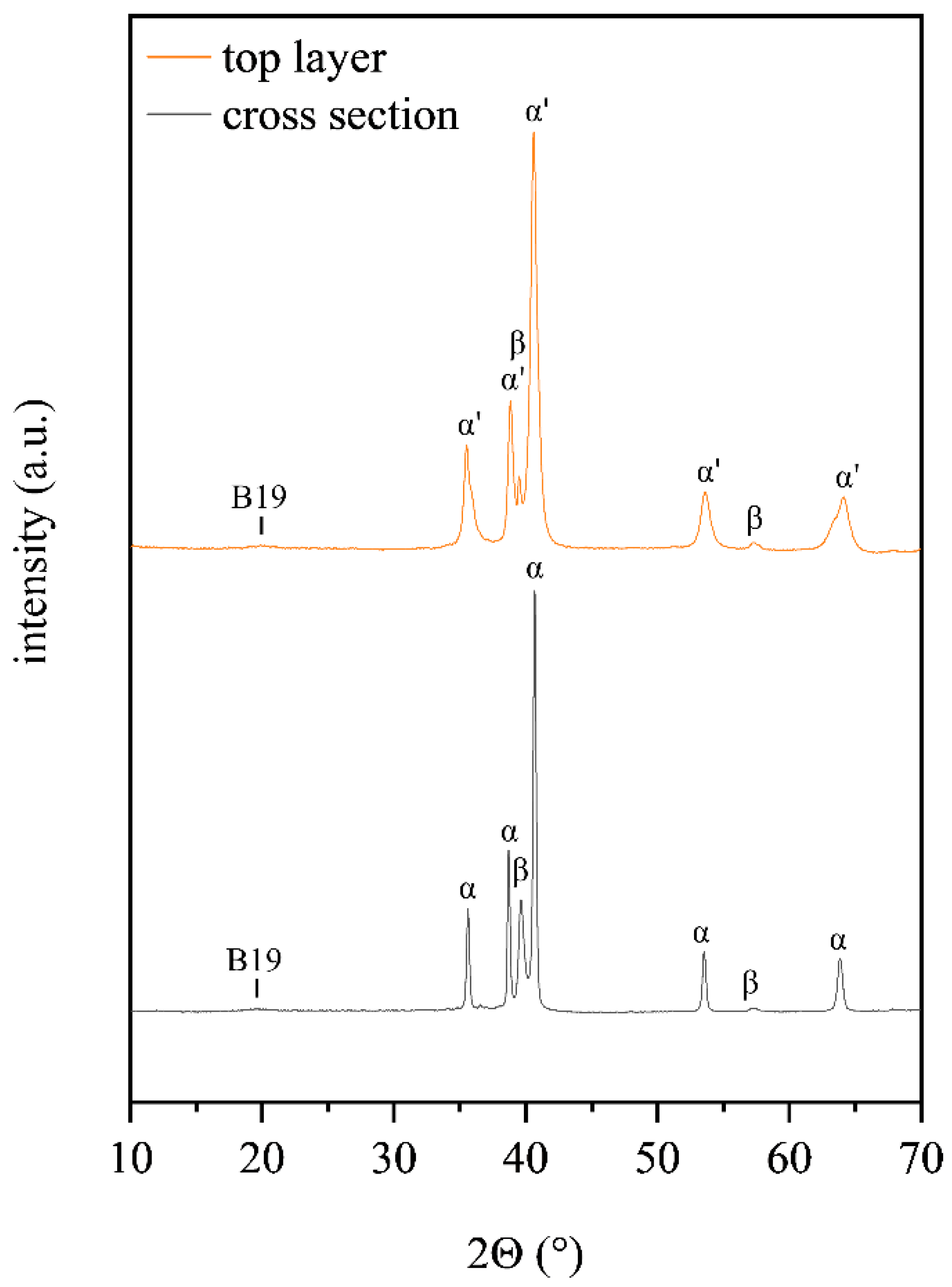
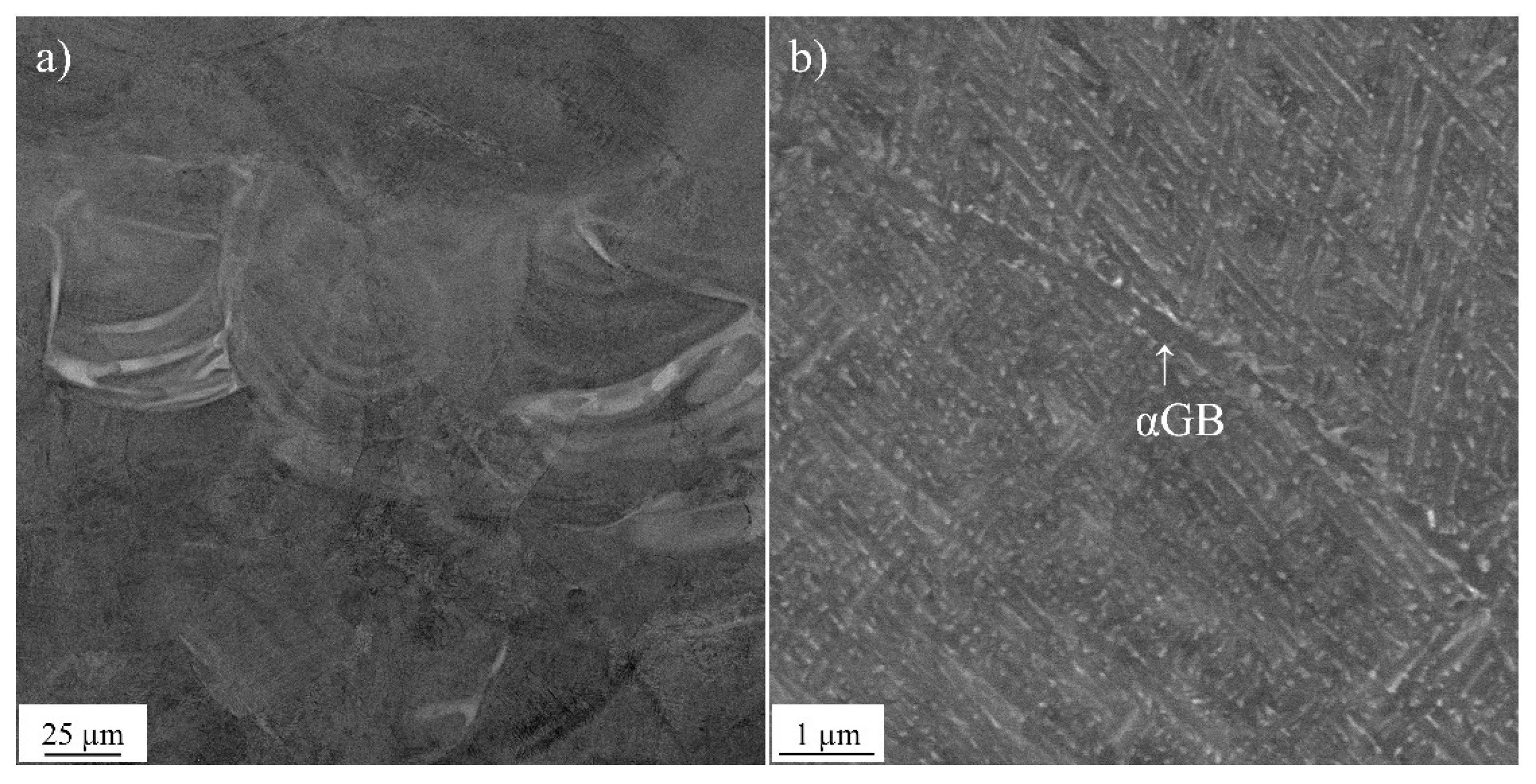

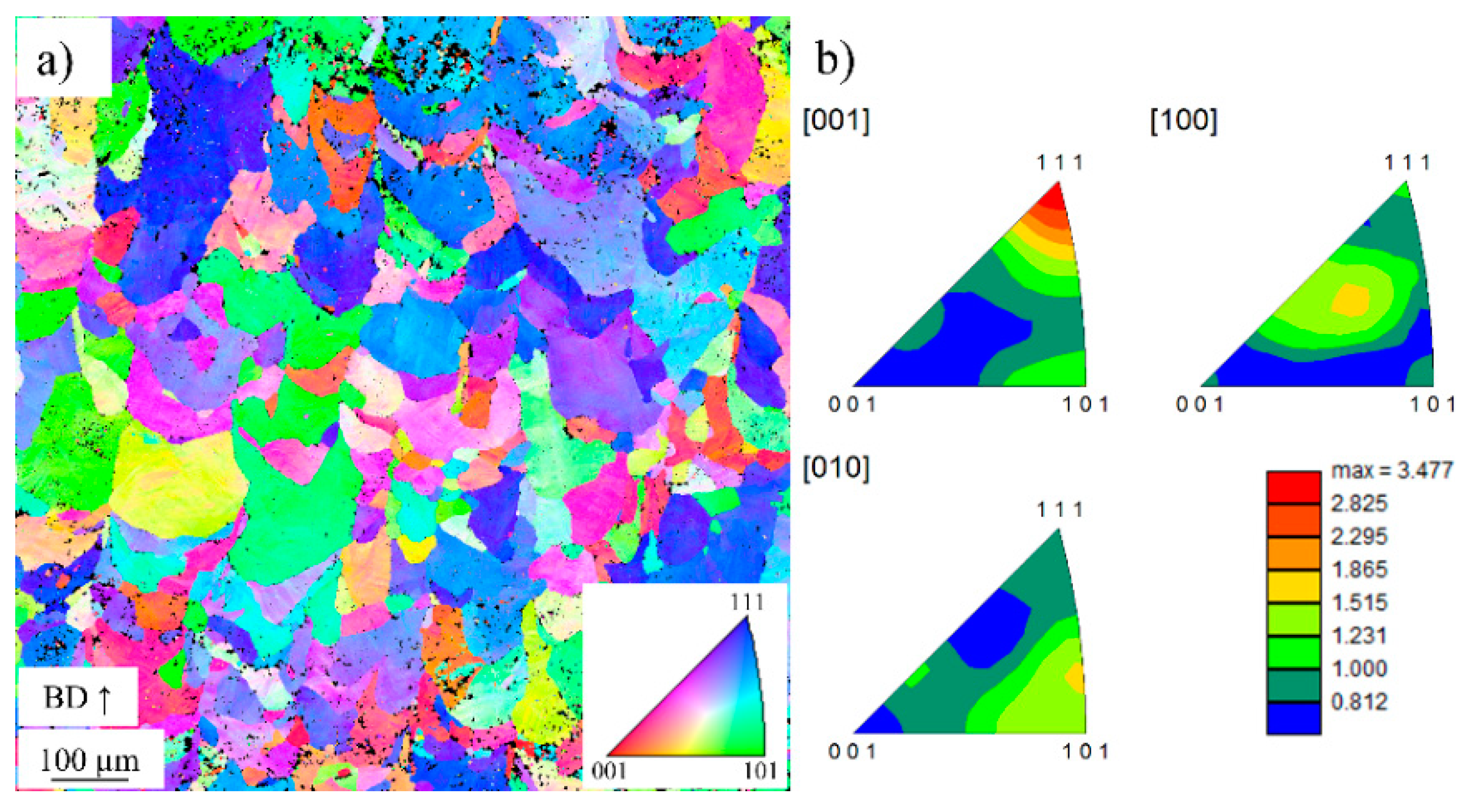
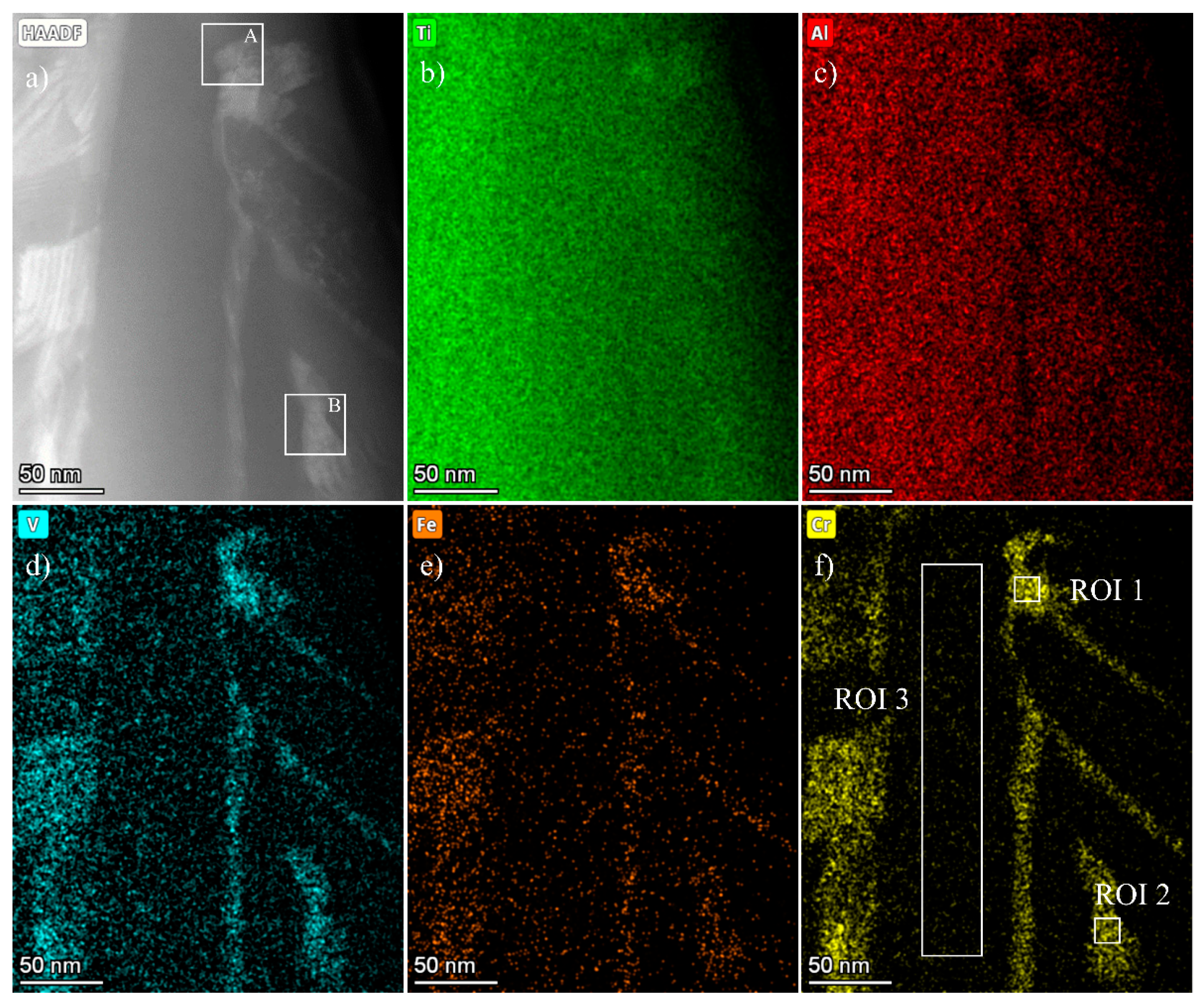
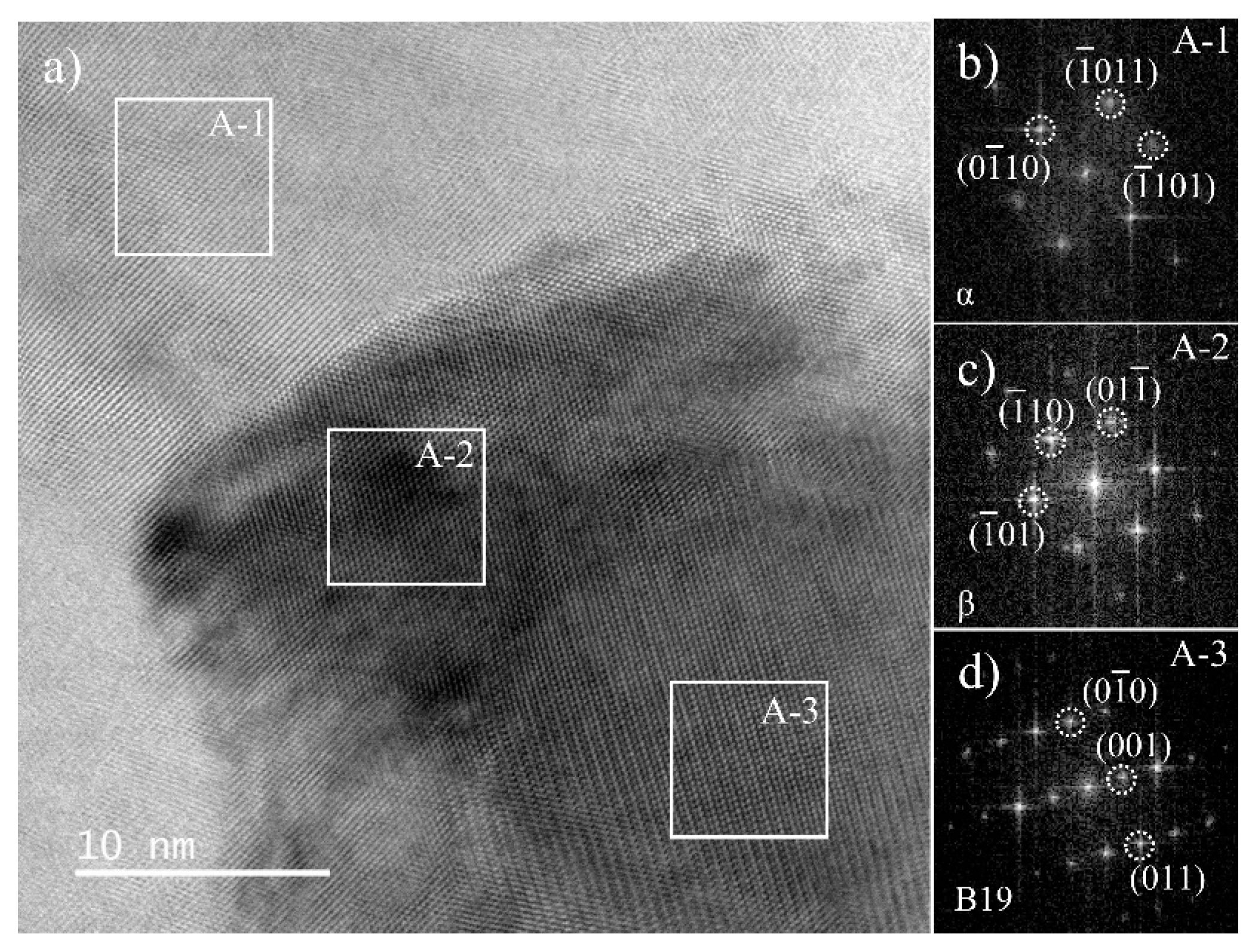
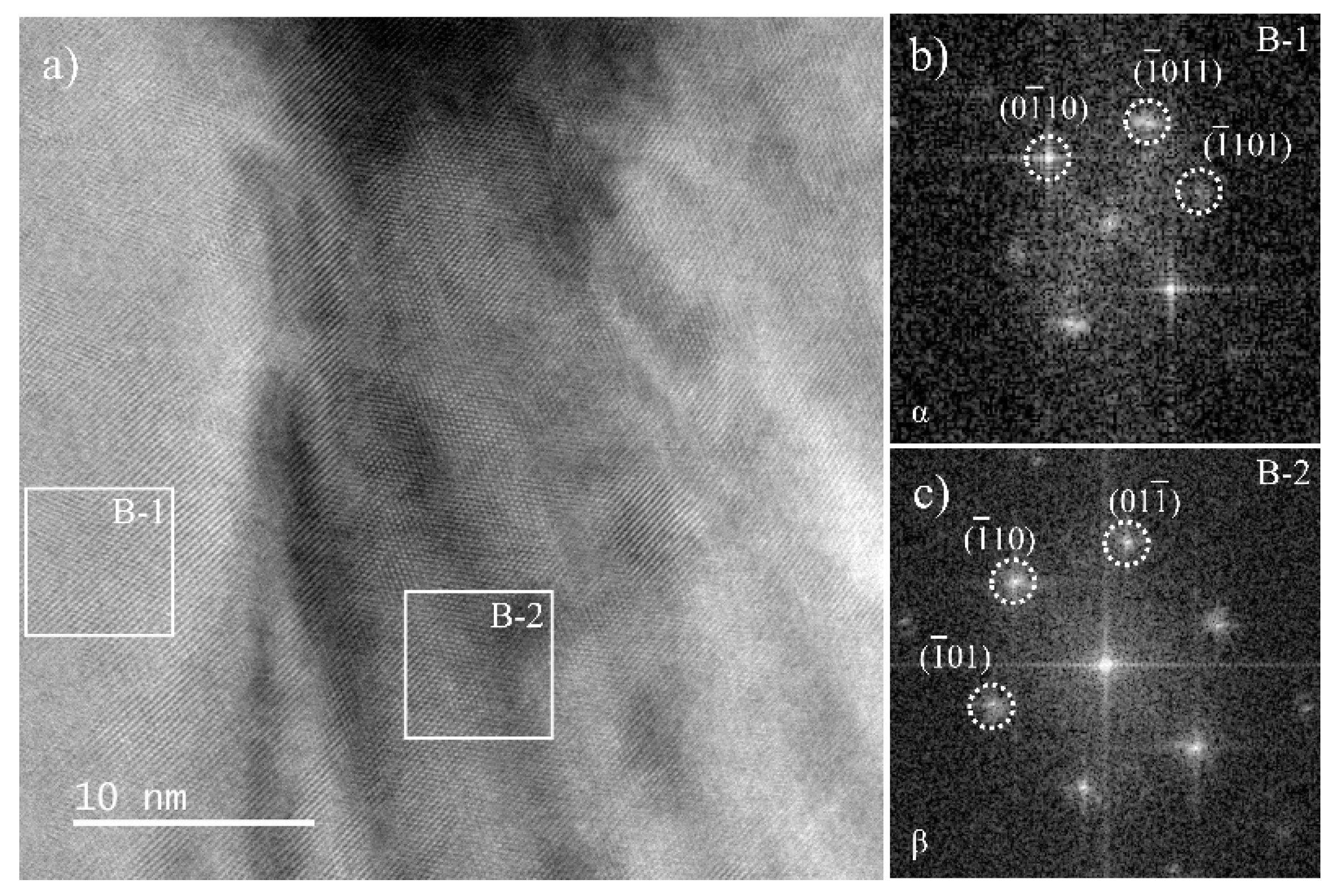

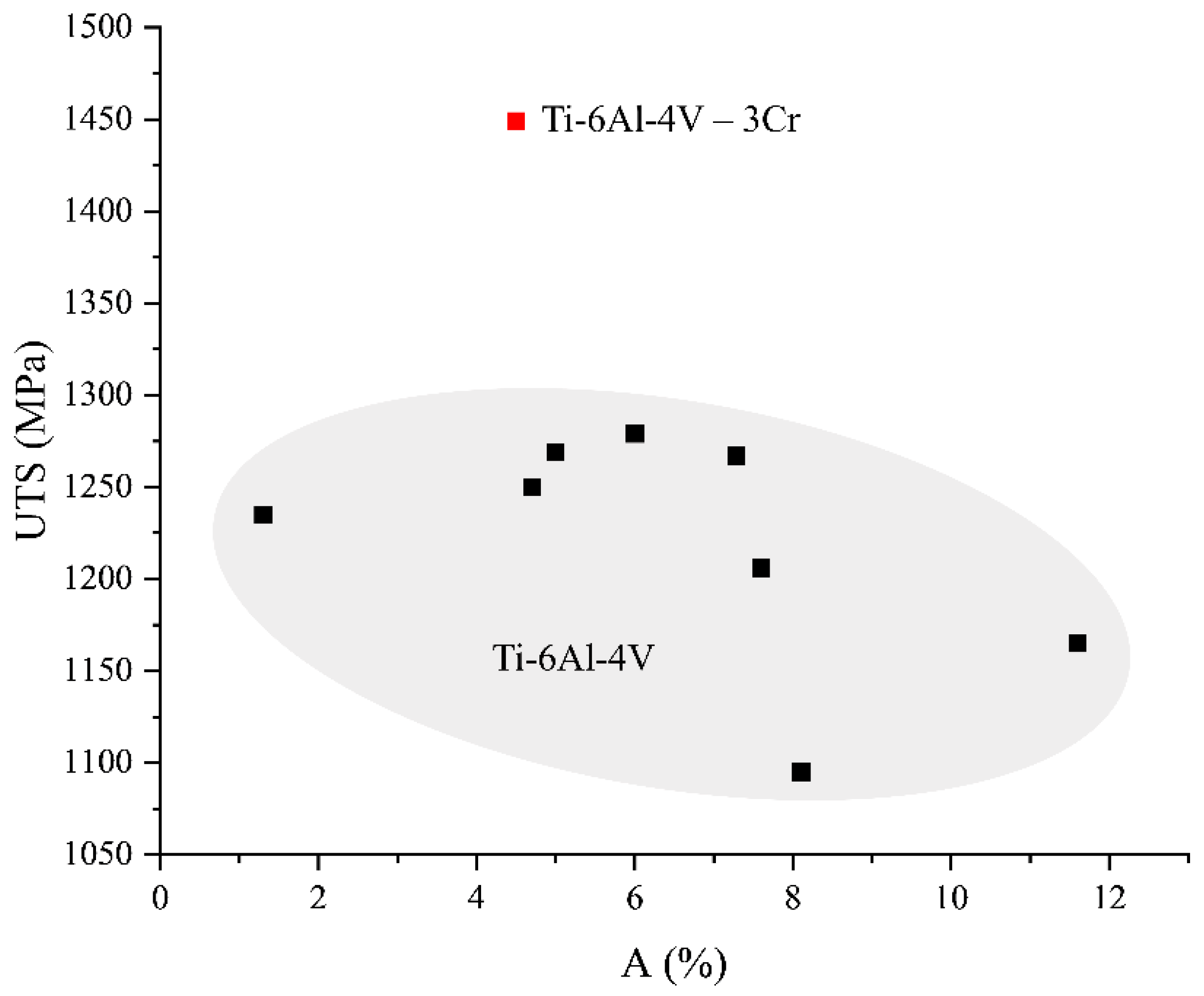
| Power (W) | Scanning Speed (mm/s) | Hatch Distance (µm) | Layer Thickness (µm) | Focus Diameter (µm) |
|---|---|---|---|---|
| 280 | 1000 | 140 | 45 | 80 |
| Material | Bulk Density (g/cm3) | Tap Density (g/cm3) | Flowability | Carr Index | Hausner Ratio |
|---|---|---|---|---|---|
| Ti-6Al-4V–3Cr | 2.47 ± 0.02 | 2.9 ± 0.2 | 2.4 ± 0.05 g/s | 0.15 | 1.17 |
| Ti-6Al-4V Powder (wt%) | |||||||
| Ti | Al | V | Fe | H | C | N | O |
| Balance | 6.16 | 4.08 | 0.18 | 0.001 | 0.012 | 0.05 | 0.13 |
| Cr powder (wt%) | |||||||
| Cr | Fe | Al | Si | C | |||
| Balance | 0.12 | 0.01 | 0.03 | 0.0037 | |||
| Ti-6Al-4V–3Cr specimen (wt%) | |||||||
| Ti | Al | V | Cr | Fe | C | N | O |
| Balance | 5.9 | 4.2 | 1.67 | 0.17 | 0.01 | 0.02 | 0.15 |
| Sampling Location | Lattice Parameters of α/α’ (Å) | Lattice Parameter Ratio c/a |
|---|---|---|
| Top layer | a = 2.918, c = 4.631 | 1.587 |
| Cross section | a = 2.913, c = 4.652 | 1.597 |
| Area | Ti (at%) | Al (at%) | V (at%) | Cr (at%) | Fe (at%) |
|---|---|---|---|---|---|
| ROI 1 | 66.82 ± 4.16 | 4.06 ± 0.54 | 16.88 ± 2.69 | 10.79 ± 1.79 | 1.45 ± 0.28 |
| ROI 2 | 72.99 ± 3.6 | 6.91 ± 0.9 | 11.14 ± 1.92 | 7.86 ± 1.39 | 1.1 ± 0.24 |
| ROI 3 | 85.05 ± 2.16 | 12.73 ± 1.83 | 1.77 ± 0.34 | 0.33 ± 0.07 | 0.12 ± 0.02 |
| Calculated Phase Composition (wt%) | |||
|---|---|---|---|
| α | β | B2 (TiFe) | |
| Ti-6Al-4V–3Cr | 94.13 | 5.87 | |
| Ti-6Al-4V–3Cr (Fe) | 93.81 | 5.87 | 0.32 |
| Rp0.2 (MPa) | UTS (MPa) | Au (%) | A (%) | |
|---|---|---|---|---|
| Ti-6Al-4V–3Cr | 1359 ± 23 | 1450 ± 22 | 1.7 ± 0.1 | 4.5 ± 0.2 |
Disclaimer/Publisher’s Note: The statements, opinions and data contained in all publications are solely those of the individual author(s) and contributor(s) and not of MDPI and/or the editor(s). MDPI and/or the editor(s) disclaim responsibility for any injury to people or property resulting from any ideas, methods, instructions or products referred to in the content. |
© 2024 by the authors. Licensee MDPI, Basel, Switzerland. This article is an open access article distributed under the terms and conditions of the Creative Commons Attribution (CC BY) license (https://creativecommons.org/licenses/by/4.0/).
Share and Cite
Goettgens, V.S.; Weber, L.; Braun, J.; Kaserer, L.; Letofsky-Papst, I.; Mitsche, S.; Schimbäck, D.; Leichtfried, G. Microstructure and Mechanical Properties of Ti-6Al-4V In Situ Alloyed with 3 wt% Cr by Laser Powder Bed Fusion. Metals 2024, 14, 715. https://doi.org/10.3390/met14060715
Goettgens VS, Weber L, Braun J, Kaserer L, Letofsky-Papst I, Mitsche S, Schimbäck D, Leichtfried G. Microstructure and Mechanical Properties of Ti-6Al-4V In Situ Alloyed with 3 wt% Cr by Laser Powder Bed Fusion. Metals. 2024; 14(6):715. https://doi.org/10.3390/met14060715
Chicago/Turabian StyleGoettgens, Valerie Sue, Luca Weber, Jakob Braun, Lukas Kaserer, Ilse Letofsky-Papst, Stefan Mitsche, David Schimbäck, and Gerhard Leichtfried. 2024. "Microstructure and Mechanical Properties of Ti-6Al-4V In Situ Alloyed with 3 wt% Cr by Laser Powder Bed Fusion" Metals 14, no. 6: 715. https://doi.org/10.3390/met14060715
APA StyleGoettgens, V. S., Weber, L., Braun, J., Kaserer, L., Letofsky-Papst, I., Mitsche, S., Schimbäck, D., & Leichtfried, G. (2024). Microstructure and Mechanical Properties of Ti-6Al-4V In Situ Alloyed with 3 wt% Cr by Laser Powder Bed Fusion. Metals, 14(6), 715. https://doi.org/10.3390/met14060715





